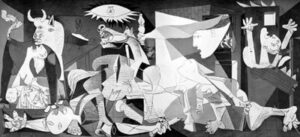 Pablo Picasso’s “Guernica” stands as one of the most powerful war protest artworks in history. Painted in 1937, this monumental piece is not just an artistic achievement but a poignant reminder of the atrocities of war, specifically the bombing of the Basque town of Guernica during the Spanish Civil War. Through “Guernica,” Picasso immortalizes the horrors of war and the suffering it inflicts upon individuals, particularly innocent civilians. This article delves into the historical context, artistic elements, and enduring legacy of Picasso’s masterpiece.
Pablo Picasso’s “Guernica” stands as one of the most powerful war protest artworks in history. Painted in 1937, this monumental piece is not just an artistic achievement but a poignant reminder of the atrocities of war, specifically the bombing of the Basque town of Guernica during the Spanish Civil War. Through “Guernica,” Picasso immortalizes the horrors of war and the suffering it inflicts upon individuals, particularly innocent civilians. This article delves into the historical context, artistic elements, and enduring legacy of Picasso’s masterpiece.
Historical Context
The bombing of Guernica on April 26, 1937, by Nazi Germany’s Luftwaffe and Fascist Italy’s Aviazione Legionaria, acting at the behest of the Spanish Nationalist forces, marked one of the first aerial bombings targeting civilians during the 20th century. The attack was designed to support General Francisco Franco’s Nationalist forces and was a testing ground for Hitler’s blitzkrieg tactics. The devastation was immense, with hundreds of civilians killed, leading to international outrage. Picasso, living in Paris at the time, was commissioned by the Spanish Republican government to create a mural for the Spanish Pavilion at the 1937 Paris World’s Fair. The tragedy of Guernica moved him to dedicate this commission to the victims of the bombing, resulting in the creation of “Guernica.”
Artistic Elements of Guernica
“Guernica” is monumental, measuring 3.49 meters (11 ft) tall and 7.76 meters (25.6 ft) wide, painted in a stark monochromatic palette. This choice of black, white, and shades of grey serves to universalize the message, stripping away the particularities of time and place to highlight the universal suffering war brings. The painting is in the style of Cubism, a movement co-founded by Picasso, which allows for multiple perspectives to be shown simultaneously, adding to the chaos and fragmentation of the scene depicted.
The composition is dense with figures and symbolism: a gored horse, a bull, dismembered and distressed figures, a woman wailing as she holds her dead child, a fallen warrior, and light—represented by a bulb and a candle—illuminating the chaos. These elements combine to convey a sense of frenzy and despair. The bull and the horse, recurrent motifs in Picasso’s work, have been interpreted in various ways, often seen as symbols of Spain itself or as representations of brutality and innocence, respectively.
Interpretation and Impact
The impact of “Guernica” is multifaceted, lying both in its artistic innovation and its emotional power. Picasso uses the mural to explore themes of pain, chaos, and death, but also resistance against injustice. The painting has been subject to myriad interpretations, reflecting on the destructive power of war, the loss of innocence, and the light of hope amidst darkness. Its lack of color emphasizes the bleakness of the event and the universality of its message.
“Guernica” quickly became a symbol of anti-war sentiment, transcending its specific historical context to speak against the horrors of war universally. It toured globally to raise awareness and funds for Spanish refugees, solidifying its status as a political and social emblem.
Legacy and Contemporary Relevance
The legacy of “Guernica” is enduring. It remains a potent symbol of the tragedies of war and a testament to the power of art to influence social and political discourse. The painting is housed in the Museo Reina Sofía in Madrid, serving as a reminder of the past atrocities and a call to peace.
Contemporary artists and activists continue to draw inspiration from “Guernica,” using art as a medium to protest against war and violence. Its influence is seen in various forms of protest art around the world, proving the timeless relevance of Picasso’s masterpiece.
Conclusion
“Guernica” is more than a painting; it is a profound statement on the inhumanity of war, an appeal for peace, and a landmark in the history of art. Picasso’s ability to convey the chaos, suffering, and emotional turmoil of the bombing of Guernica, while also invoking a universal message against violence, is unparalleled. Through “Guernica,” Picasso not only commemorates the victims of this specific tragedy but also offers a timeless reminder of the cost of war on human lives and spirits. This masterpiece remains a powerful testament to the capacity of art to bear witness to history, to provoke, to mourn, and ultimately, to hope for a more peaceful world.

























